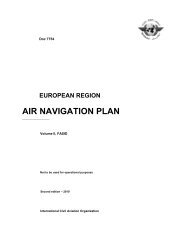7754 Vol 1 Flyleaf - ICAO Public Maps
7754 Vol 1 Flyleaf - ICAO Public Maps
7754 Vol 1 Flyleaf - ICAO Public Maps
Create successful ePaper yourself
Turn your PDF publications into a flip-book with our unique Google optimized e-Paper software.
Part V<br />
AIR TRAFFIC MANAGEMENT (ATM)<br />
1. Controlled airspace should be established so as to<br />
encompass the climb to cruising level of departing aircraft,<br />
the cruising levels on ATS routes normally used by IFR<br />
flights and the descent from such levels of arriving aircraft,<br />
except in those cases where the type and density of traffic<br />
clearly do not justify the establishment of controlled airspace.<br />
Provisions should be made to ensure that SST aircraft are<br />
able to conduct the transonic and supersonic phases of their<br />
flights within controlled airspace, regardless of density of<br />
traffic.<br />
[Annex 11, Chapter 2]<br />
Note.— Detailed provisions regarding the type of air<br />
traffic service required are highlighted in 1 to 7 of Part V.II<br />
— ATS.<br />
2. The lower limit of controlled airspace should be<br />
established so that:<br />
a) IFR flights requiring the provision of air traffic control<br />
service can remain within controlled airspace during the<br />
entire duration of their flight; and<br />
b) flights not requiring ATC services are not unnecessarily<br />
restricted.<br />
In the vicinity of aerodromes, the establishment of the lower<br />
limit of controlled airspace should also take into account<br />
those portions of the airspace which may be required by ATC<br />
in order to vector aircraft by radar.<br />
[Annex 11, 2.9.3]<br />
3. Controlled airspace should be established in the<br />
upper airspace up to flight level 460 and throughout the<br />
whole control area whenever area type air traffic control<br />
service is provided.<br />
[EUM/VI, Rec 8/13]<br />
Part V.I<br />
AIRSPACE MANAGEMENT (ASM)<br />
V-1<br />
4. Airspace restrictions and/or temporary airspace<br />
reservations for specific users or purposes should only be<br />
imposed when the intended purpose cannot be met by other<br />
arrangements. If established, such restrictions and/or<br />
reservations should be kept to the minimum, both in extent<br />
and duration consistent with the purpose they serve and<br />
should be withdrawn as soon as possible. In addition, any<br />
restricted and/or reserved airspace should be made available<br />
for general use whenever the activities having led to their<br />
establishment are temporarily suspended, e.g. during<br />
weekends, at night, etc. (18, Part II — GEN also refers).<br />
[Annex 11, 2.17]<br />
5. Where users have specific requirements in portions<br />
of the airspace extending over the territory of a number of<br />
States and/or over the high seas, arrangements should be<br />
made between States concerned for the coordinated use of<br />
airspace, facilities and procedures in order to ensure<br />
maximum uniformity.<br />
CIVIL/MILITARY COORDINATION<br />
[Annex 11, 2.16 and 2.17;<br />
Air Traffic Services Planning Manual<br />
(Doc 9426), Part II, Section 1, Chapter 2]<br />
6. States should aim at the creation of one single<br />
integrated system catering to both civil and military<br />
requirements. The related organization of the airspace<br />
should satisfy the requirements of all users in an optimum<br />
way.<br />
7. States should establish civil/military coordination<br />
bodies to ensure, at all levels, the coordination of decisions<br />
relating to civil and military problems and airspace and<br />
traffic management (paragraph 4 above refers).














